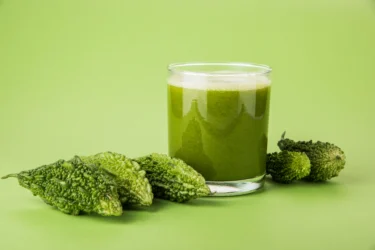Karela Juice: Uses, Benefits, Side Effects and More!
By Dr Smita Barode +2 more

Get,

to manage your symptom
Get your,


4 Cr+ families
benefitted

OTP sent to 9988776655



You’ve successfully subscribed to receive
doctor-approved tips on
Whatsapp

Get ready to feel your best.

Hi There,
Download the PharmEasy App now!!


Register to Avail the Offer
Send OTPBy continuing, you agree with our Privacy Policy and Terms and Conditions

Hi There,
Sign up on PharmEasy now!!
Trusted by 4 crore+ families

OTP sent to 9988776655



You have unlocked 25% off on medicines




Code: NU25
By Dr Smita Barode +2 more
Table of Contents
Karela might be one of those vegetables that can stir up quite a drama in Indian households. You can imagine the tears and screams of kids not wanting to eat it because of its bitter taste and parents wanting them to because it’s healthy. Growing up, it’s probably one of the vegetables which we try to avoid. But should we? Probably not. Let’s find out more about it.
Karela is also known as Momordica charantia in the scientific community. Commonly it has many more names like bitter melon, bitter-gourd and balsam pear. It is a flowering vine and belongs to the family Cucurbitaceae. It is popular among the populations of South America, the Caribbean, East Africa, Asia and India. It has a pronounced bitter taste, hence the name. This bitter fruit is used for cooking and might have potential benefits as well1.

Karela is oblong-shaped and green in colour; it later turns yellow or orange in colour when it ripens. It is hollow in the centre and has a thin rind of flesh and flat seeds inside. The outer surface of karela is prickly or warty in appearance2.
The nutrition content of bitter gourd is:
Other nutrients present in karela:
Karela possesses various properties. Maybe these properties are the reason for its medicinal uses. The following properties are exhibited by karela:
As we know, science is always on the lookout for solutions to health problems with no or minimum side effects. So, a lot of research is being conducted on various compounds. Similarly, studies of various kinds are being conducted on karela juice too to know about its benefits, side effects and safety of use. There is still a long way to go; however, current data suggest that karela juice might have the following potential uses.

Karela might have the potential to help with high blood sugar. Studies1 have also shown that karela might help and have a better effect than some of the common components used for managing elevated blood sugar. Therefore, there is a chance that karela juice might help with high blood sugar. However, there is a need for further studies to claim its potential use for human health.
Studies5 have shown that the Karela extracts have antioxidant and hypoglycemic effects that may aid in diabetes and obesity. I strongly recommend the addition of Karela juice in moderation for an effective weight loss journey.
Dr. Siddharth Gupta, B.A.M.S, M.D (Ayu)

In a study4 conducted in 2012 by Buddhachat et al. from Thailand, it was found that the fruit of karela was effective against a parasite that infests the stomach. This study was conducted on animals. It was also observed that with an increasing concentration and time, it was more effective in destroying the infesting worm. Therefore, karela juice might potentially help with worms infesting the stomach. However, further human studies are required to establish its safety and efficacy.

In a study2 conducted on animals by Tenmhozi and Subramanian, it was found that karela might potentially reduce oxidative stress in the body. Therefore, karela juice might help in neutralising the free radicals in the body and helping with various diseases caused by free radicals. However, there is a need for further studies in humans to establish the antioxidant property of karela juice.

Jain et al. have found in their study2 that karela might have the potential to alleviate pain. The study hypothesises that this effect may be due to the combined action of karela juice on the nerve pathways that carry the message of pain by inhibiting certain compounds necessary for inflammation and acting as an antioxidant. In another study, Hsu et al. found that karela might help with inflammation. Therefore, it might be possible for karela juice to alleviate inflammation, which is involved in the pathology of many conditions. However, there is a need for much more extensive research to state the effect of karela juice on inflammation as a concrete fact. So, you should always consult a doctor before using karela juice for any medicinal purpose.

Several studies2 conducted have shown that karela juice might help with cancer. For example, Weng et al. have found that the extract of wild bitter gourd has compounds which might help with breast cancer. Kwatra et al. studied bitter gourd for colon cancer and concluded that it might help in fighting against it. Kaur et al. studied the effects of karela and its compounds on pancreatic cancer and have found that it indeed had the potential, which further research may lead to conclusive answers. Similarly, various studies found that karela juice might help with cancer of various kinds. However, there is much ambiguity regarding it, and it requires much more extensive research to claim the effectiveness and safety of karela juice for dealing with cancer.
Though there are studies that show the potential use of karela juice in various conditions, these are insufficient, and there is a need for further studies to establish the true extent of the benefits of karela juice on human health.
In my experience, Karela juice might help with piles. Karela is known for its anti-inflammatory property that may relieve the symptoms of pain and swelling associated with piles. Karela may also improve digestion which may contribute to the relief from the pain associated with piles.
Dr. Rajeev Singh, BAMS
You can make fresh karela juice at home. First, you should take a fresh karela and wash it thoroughly with water. Then you should cut it into smaller pieces and remove the seeds. Then you can put the cut pieces into a mixer grinder and make them into a fine juice.
You must consult a qualified doctor before taking any herbal supplements. Likewise, do not discontinue or replace an ongoing treatment or medicine with an Ayurvedic/herbal preparation without consulting a qualified doctor.
Also Read: Aloe Vera Juice: Uses, Benefits, Side Effects and More!
There isn’t sufficient evidence to state the side effects of karela juice nor to say that it doesn’t have any. Therefore, there is a need for extensive research on animals and humans to prove any claims or to be used for human health.
All foods should be taken in moderation. Likewise, karela juice should also be taken in moderation and under supervision and as prescribed by your doctor. However, special care should be taken, and doctor’s consultation much more frequently and in detail is required for pregnant and breastfeeding women, elderly individuals and children. Kindly do not self-medicate, discontinue or substitute any ongoing treatment or medicine prescribed by your doctor. Please consult a doctor for any health-related concerns that you may have.
There is a requirement for more studies and experiments to consider karela juice entirely safe and to conclude that it doesn’t react adversely with any drug. Karela juice might react with drugs under some conditions. Therefore, you should always consult with a doctor before using it. Kindly do not self-medicate or discontinue an ongoing treatment on your own. Please consult a doctor. They will tailor prescriptions as per your health conditions and requirements.
Yes. Karela contains many nutrients and bioactive compounds. It might have the potential to help with high blood sugar, inflammation, cancer, etc1,3. However, further studies are required to establish its health benefits for humans.
Several studies1 have shown that karela juice might have the potential to help with high blood sugar. This may be due to the presence of bioactive compounds in it. However, there is a requirement for more studies to prove the effect and safety of karela juice for diabetes in humans. Kindly consult a doctor if you have a condition. Do not self-medicate or discontinue any medication on your own.
There are no valid reports that claim the effects of karela juice for getting good skin. Moreover, it is advised that you consult a doctor for any problems that you face. Please do not self-medicate.
No. Karela juice is made using the fruit of the karela plant. You can use fresh karela from the market to make the juice. Wash the karela thoroughly, then cut it into smaller pieces. Remove the seeds and then use a mixer grinder to get fresh karela juice.
No valid reports have claimed that karela helps to get good eyesight. Therefore, there is a need for more study in this area.
You should consult an Ayurvedic physician for the dosage and form of use of karela for its benefits. They will guide and prescribe you the dosage. Ensure that you consult a doctor before using any Ayurvedic herbs or preparations. Please do not self-medicate.
There are no documented reports that claim karela juice to be helpful for hair. There is a lack of data regarding this subject, and it will require more research.
1. Joseph B, Jini D. Antidiabetic effects of Momordica charantia (bitter melon) and its medicinal potency. Asian Pacific J Trop Dis [Internet]. 2013 Apr;3(2):93–102. Available from: https://linkinghub.elsevier.com/retrieve/pii/S2222180813600523
2. Dandawate PR, Subramaniam D, Padhye SB AS. Bitter melon: a panacea for inflammation and cancer. Chin J Nat Med [Internet]. 2016;14(2):81–100. Available from: https://www.ncbi.nlm.nih.gov/pmc/articles/PMC5276711/
3. Bello OA, Ayanda OI, Aworunse OS, Olukanmi BI. An Update Review on the Anthelmintic Activity of Bitter Gourd, Momordica charantia. 2018;1(2):31–4. Available from: https://www.ncbi.nlm.nih.gov/pmc/articles/PMC5414453/
4. Poolperm S, Jiraungkoorskul W. An Update Review on the Anthelmintic Activity of Bitter Gourd, Momordica charantia. Pharmacogn Rev. 2017 Jan-Jun;11(21):31-34. doi: 10.4103/phrev.phrev_52_16. PMID: 28503051; PMCID: PMC5414453. Available from: https://pmc.ncbi.nlm.nih.gov/articles/PMC5414453/
5. Alam MA, Uddin R, Subhan N, Rahman MM, Jain P, Reza HM. Beneficial role of bitter melon supplementation in obesity and related complications in metabolic syndrome. J Lipids. 2015;2015:496169. doi: 10.1155/2015/496169. Epub 2015 Jan 12. PMID: 25650336; PMCID: PMC4306384. Available from: https://pmc.ncbi.nlm.nih.gov/articles/PMC4306384/
Disclaimer: The information provided here is for educational/awareness purposes only and is not intended to be a substitute for medical treatment by a healthcare professional and should not be relied upon to diagnose or treat any medical condition. The reader should consult a registered medical practitioner to determine the appropriateness of the information and before consuming any medication. PharmEasy does not provide any guarantee or warranty (express or implied) regarding the accuracy, adequacy, completeness, legality, reliability or usefulness of the information; and disclaims any liability arising thereof.
Links and product recommendations in the information provided here are advertisements of third-party products available on the website. PharmEasy does not make any representation on the accuracy or suitability of such products/services. Advertisements do not influence the editorial decisions or content. The information in this blog is subject to change without notice. The authors and administrators reserve the right to modify, add, or remove content without notification. It is your responsibility to review this disclaimer regularly for any changes.
Comments

Leave your comment...
You may also like
Comments